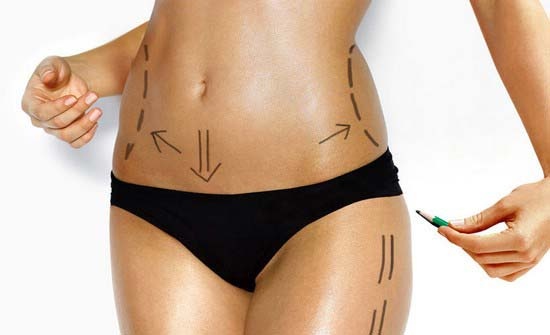Article about a rasvaimu, plastiikkakirurgia and rintojen suurennus

Firstly, to date, by low-invasive and relatively safe way recognized rasvaimu — suction of subcutaneous fat using a special cannula vacuum suction after anesthesia. First through the cannula into the subcutaneous fat pumped liquid, good solvent fat. When the fat is dissolved, the solution was sucked off. For the treatment of large surfaces have to make some holes. Since the number of fat cells in human body invariably strictly from the moment of birth until the moment of death, liposuction can solve the problem radically. Where fat cells are removed, they no longer appear, and fat there will be no more.
Especially liposuction with uneven distribution of subcutaneous fat, mainly its accumulation in the abdomen, flanks and buttocks. Sometimes the fat «round up» is extremely difficult, because in these places the density of insulin receptors in adipose tissue is several times higher than in others. Fat disappears from your hands, legs, face, etc., and on the abdomen and flanks may still be body fat, which never disappears, despite all efforts. For such cases, and there is liposuction. Each surgical method of fat removal has its advantages and disadvantages. Experienced specialist in cosmetic surgery can always recommend the option which in this case would be the most successful.
Secondly, plastiikkakirurgia as field of surgical activity is engaged in the development of methods of surgical treatment of patients with deformity of the soft and bone tissues, various malfunctions in any part of the body. Plastic surgery is needed in order to free people from physical disabilities, to transform their appearance. Physical defects can be of different nature: congenital, acquired due to accident or postoperative. Various methods of carrying out plastic surgery will hide any defects and deficiencies so that the patient will feel comfortable in his new look.
Plastic surgery is classified into several types: cosmetic and reconstructive.
Aesthetic surgery deals exclusively externally patients, correction of forms according to the interdependence of all parts of the body, without going far beyond the age and ethnicity of each individual.
Between aesthetic and reconstructive plastic surgery revealed a main significant difference. To reconstructive surgery seeks help a person suffering from lack of tissues, and any healthy person who wants to fine-tune its appearance, you may seek assistance from the professionals of aesthetic plastic surgery.
Often operations are performed for the correction of any imbalances of the face, such as nose. And when some people with age complexes arise in connection with their external changes, and subsequently lowered self-esteem and destabilizing emotional.
In the above cases, plastic surgery is just needed for people who want to live a full life. Aesthetic medicine is a more newly-formed paths in plastic surgery and requires thorough preparation.
The media, of course, report what people are most interested in: about the various diets, the political fights, the sex, «beautiful people», etc. Aesthetic surgery also not paid attention to and included in this list. Because of this, it became known as «vanity surgery». With such disdain are people who have not had to experience the need for plastic surgery, it seems frivolous occupation.
The plastic surgeon is able to correct all deficiencies and make almost any person beautiful. Let's not forget that in aesthetic medicine the object of treatment is not part of the body or face, and the patient as an individual. A plastic surgeon is obliged to understand specifically what results from the operation waits for the patient, and should know whether it is possible to realize these desires, and to assess their abilities with the ideas of the client.
Thirdly, rintojen suurennus is an operation that relate to the field of reconstructive and aesthetic surgery. This operation can occur for aesthetic reasons, for example if desired the woman or girl to have bigger Breasts to increase breast size), or just to have beautiful Breasts, ie change its shape, and for medical reasons, a doctor's appointment, (for example, the female breast is malformed or should be restored after amputation).
Growing demand for plastic surgery to increase the breast due to the fact that it is quite effective and a safe procedure that does not require the patient for a long period of rehabilitation.
Thus, breast enlargement with implants (plastic surgery) remains the most widely recognized, proven and popular method. The use of silicone implants in aesthetic medicine endorsed by leading plastic surgeons and time-tested. Numerous scientific studies prove that the presence of implants does not cause cancer, immunological and other diseases. Safety of modern implants are made of biologically neutral multilayer shell and gel filler that is proven by independent companies for quality control of medicines.
Surgery for breast augmentation is contraindicated in the presence of certain diseases, namely cancer of the breast, poor blood clotting, autoimmune diseases, diabetes, lung diseases, in diseases of an infectious nature, as well as people with diseases of the nervous system. Surgery for breast augmentation, it is recommended to do after 18 years, when the Breasts of the girl was finally formed. Ie if you have a child, forget the breast augmentation for a few years, perhaps your Breasts will increase their own natural way.
Passing a thorough examination before surgery for breast augmentation definitely, the examination gives the doctor a complete picture of your health. After analysis of the survey results, the doctor decides about the possibility of surgery for breast augmentation.
Indications for surgery breast enlargement:
- small natural breast size (micromasty);
- drooping of the breast (usually caused by childbirth and breastfeeding);
- severe breast asymmetry.
Contraindications to breast augmentation surgery:
- Severe diseases of internal organs;
- Diabetes;
- Bleeding disorders;
- Infectious diseases and cancer;
- Incomplete lactation.






0 комментариев